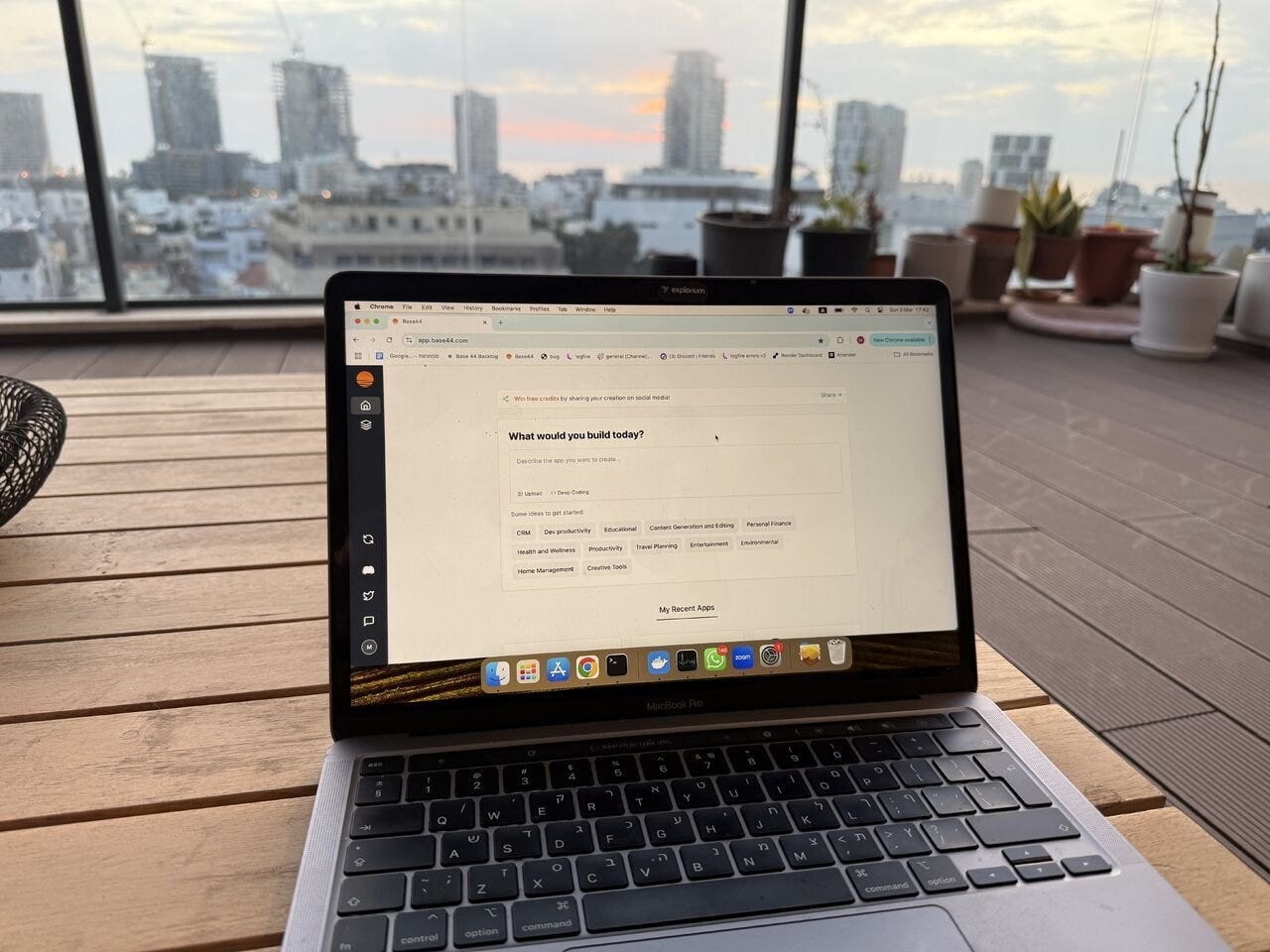ANOTHER DAY
ANOTHER STARTUP STORY
There’s a buzz in the startup world about the rise of “solo unicorns” – one-person companies supercharged by AI to billion-dollar heights.
While Base44 didn’t reach unicorn status, its story is a compelling real-world example of how far a solo founder with AI prowess can go.
In just six months, Base44 grew from a personal side project into a viral app-building platform:
300,000+ users.
$3.5M ARR.
Partnerships with eToro and Similarweb
$189K profit
And sold to web giant Wix for a reported $80 million in cash.
And here’s the kicker:
It achieved this feat with no venture funding + a team you could count on two hands.
How did a tiny, bootstrapped startup pull off such a dramatic sprint?
Let’s dive into Base44’s journey – a tale of tech, timing, and a bit of “vibe coding” magic.
At the end of this, I’ll break down 6 founder takeaways you can steal today — from product strategy to low-cost growth tactics.
“Just a side project” after reserve duty
The story begins with Maor Shlomo, a 31-year-old Israeli developer and entrepreneur.
Maor was no newcomer to startups – he had previously co-founded a successful data analytics company, Explorium, which raised about $130 million.
But in late 2024, after finishing a stint of reserve military service, Maor found himself itching to build something new.
“It began as something I’d tinker with” — he said
By January 2025, that little side project experiment had become a legit company.
At first, it was messy.
The product broke often.
Stability was far from perfect.
But Maor launched early, and shipped constantly.
He says he pushed to production 13 times a day in the early weeks.
That raw speed paid off.
Fresh off his big-data venture, he wanted to tackle a new frontier: making it possible for anyone to create software simply by talking to a computer.
A “vibe coding” moonshot
Maor describes Base44 as a moonshot experiment — helping everyone, technical or not, build software without coding at all.
In essence, Base44 is part of a new wave of AI-driven “vibe coding” platforms that turn natural language into fully functional applications.
Instead of writing code, users of Base44 just describe what they want the app to do in plain English, much like chatting with ChatGPT.
Under the hood, Base44’s AI handles all the heavy lifting:
setting up databases
authentication
backend logic
deployment
Want to build a web app or a mobile game?
You simply type your idea (a prompt), and Base44 generates a working application complete with login systems, data storage, analytics, email integration, even map features – no code or developer team required.
Building something people share
Maor’s early users weren’t strangers — they were:
friends
ex-colleagues
people from WhatsApp groups that he joined.
He didn’t sell to them.
He asked for feedback.
The first 10 users came slowly.
But once a few started building real things and sharing them, growth picked up.
By the end of month one: 10,000 users.
A few months later? 300,000+ users
The key wasn’t paid growth.
It was virality.
“If I were to do it again, I’d first make sure users love the product to the point they’re sharing it—even if it’s just your first 10 or 50—before doing any marketing.” — he said.
That early shareability created a natural pull.
Even when Maor was offline fixing bugs, users kept coming in.
Building in public and going viral
Unlike many stealthy startups, Base44’s growth happened out in the open.
Maor didn’t run ads.
He didn’t hire marketers.
He built in public, regularly posting updates, prototypes, and even setbacks on social media.
On LinkedIn and Twitter (now X), he shared the journey and about what he was learning, building, and struggling with – from technical tips to hard numbers – and this transparency helped drive massive word-of-mouth buzz.
Not sales content.
Just stories.
“I wrote content that wasn’t selling Base44. But people would read it and say, ‘Hmm, I wonder what this guy actually builds.’” — he said.
He wrote two types of content:
Valuable posts that resonated with builders (his target audience)
Product updates (which created curiosity and momentum)
Some users only converted after seeing 10+ updates.
But they did convert.
Scrappy and profitable
Maor didn’t raise funding.
He bootstrapped Base44 with around $10K–20K of his own money — most of it went to LLM usage and some failed influencer experiments.
He used Cursor as his dev environment.
He even used Base44 to build Base44!
And despite all odds, he made it profitable.
In May 2025, the company pulled in $189K profit.
One-man startup.
Bootstrapped.
No full-time team.
The bottleneck
Of course, the ride wasn’t smooth the whole way.
One of Maor’s biggest bottleneck was infrastructure cost.
Because Base44 relied on large language models to generate full-stack code in real time, every single request carried a cost.
As users piled on, Maor faced a serious dilemma:
“Being bootstrapped meant every token cost came out of my pocket.”
To stay profitable, he had to optimize aggressively:
Prompt caching to avoid redundant generation
Model ensemble to switch to cheaper LLMs when possible
Context trimming to shrink the payload and reduce token usage
It took experimentation and fine-tuning, but it worked.
The margins got healthier, and Base44 could handle user growth without bleeding cash.
MORE STORIES AND INSIGHTS:
🔗 A 22-year-old quit Y Combinator to go full time on bootstrapping his college hackathon project
🔗 Your startup only needs 1,000 true fans
🔗 Business is shockingly simple, but surprisingly hard!
When doctors, NGOs, and teachers showed up
The real “aha” moment for Maor wasn’t ARR or virallity.
It was when people started using Base44 for things he’d never expected:
Doctors organizing patient data
NGOs coordinating disaster relief
Teachers planning lessons
A clinic building a custom mental health tracker
That’s when it stopped being a tech demo and became something people needed.
The Wix acquisition
All this momentum inevitably drew interest from bigger fish.
One of those was Wix.com, the publicly traded website-building platform known for helping millions create websites with no coding.
Recently, June 2025, Wix acquired Base44 for ~$80 million in cash.
Wix CEO Avishai Abrahami said it best:
“Maor’s cutting-edge technology aligns perfectly with our mission to empower creators.”
The deal made headlines across Israel’s tech scene.
But Maor had already hinted at needing scale:
“The scale and volume we need is not something we can organically grow into.”
He didn’t sell because Base44 was failing.
He sold because it had outgrown his one-man bandwidth.
What founders can learn from Maor
Here are some no-BS takeaways from his journey:
→ 1. Product comes first.
Before you worry about scale, virality, or monetization…
Get 5–10 people to love it.
Not just use it.
→ 2. Don’t skip the uncomfortable asks.
Your first users are probably already in your life!
Beg your friends and family to try it.
It matters.
→ 3. If it’s not shareable, fix that first.
Viral loops > paid growth (especially if bootstrapped).
Before scaling, ask: “would someone want to share this?”
If not, you’ll burn money or time trying to grow something with no inherent pull.
→ 4. Document, don’t sell.
People follow stories more than products.
It built trust.
And trust brought in users who wanted to check out what you are building.
→ 5. Don’t overspend early.
Only spend within your budget at early-stage.
It’s easy to burn money before your product is ready — but don’t
Wait for strong retention before even trying to scale.
→ 6. Scale only after users love it.
If your users aren't excited about your product, no marketing budget will fix that.
But once they are? — Every tweet, ad, and feature update works exponentially better.
That’s when you start pouring fuel on the fire.
Final thoughts
Base44’s journey reads like a startup fairy tale – or as Maor himself said, a “crazy” ride.
It’s the kind of story that fuels the dreams of indie developers and solo founders everywhere.
Of course, not every side project will turn into an eight-figure exit.
But Base44 shows that in this era of powerful AI tools, a lean team (or even a lone determined coder) can create something with global impact at breakneck speed
For me, I believe Base44 didn’t succeed because it was AI.
It succeeded because one founder:
Obsessively built a product users loved
Shared that journey openly
Focused on the 10 people who cared, not the 10,000 who didn’t
Whenever you're ready, there are 3 more ways I can help you:
1. Promote your business to 1,000+ readers:
A shoutout right at the top of the email that can include a banner, a headline, 4 sentences, and a CTA button. A featured sponsor mention in 3 back-to-back newsletter issues for maximum visibility.
2. Share your startup story:
A dedicated feature/spotlight in our newsletter, including a compelling write-up of your startup’s story and mission, and a link to your website or landing page. Let's us tell your story!
3. Book a 1-on-1 call with Gracie:
In one hour, let's help you get unstuck and map out an actionable plan to acquire your first 100-1000 customers fast.See you next issue!
Gracie from What A Startup











A great insight! You probably already know your first 5-10 customers.